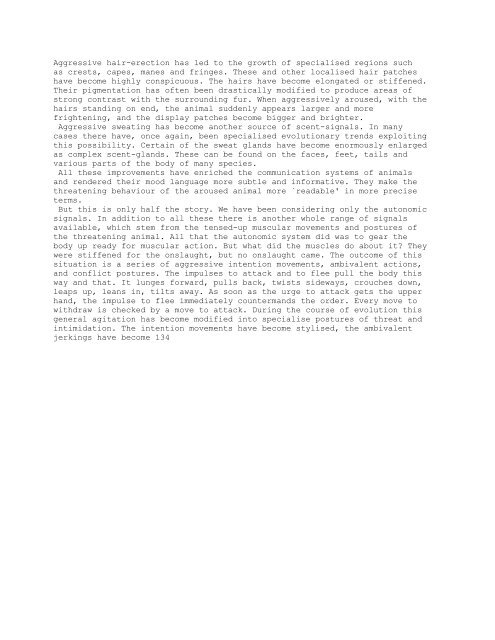You also want an ePaper? Increase the reach of your titles
YUMPU automatically turns print PDFs into web optimized ePapers that Google loves.
Aggressive hair-erection has led to the growth of specialised regions such<br />
as crests, capes, manes and fringes. These and other localised hair patches<br />
have become highly conspicuous. The hairs have become elongated or stiffened.<br />
Their pigmentation has often been drastically modified to produce areas of<br />
strong contrast with the surrounding fur. When aggressively aroused, with the<br />
hairs standing on end, the animal suddenly appears larger and more<br />
frightening, and the display patches become bigger and brighter.<br />
Aggressive sweating has become another source of scent-signals. In many<br />
cases there have, once again, been specialised evolutionary trends exploiting<br />
this possibility. Certain of the sweat glands have become enormously enlarged<br />
as complex scent-glands. These can be found on the faces, feet, tails and<br />
various parts of the body of many species.<br />
All these improvements have enriched the communication systems of animals<br />
and rendered their mood language more subtle and informative. They make the<br />
threatening behaviour of the aroused animal more `readable' in more precise<br />
terms.<br />
But this is only half the story. We have been considering only the autonomic<br />
signals. In addition to all these there is another whole range of signals<br />
available, which stem from the tensed-up muscular movements and postures of<br />
the threatening animal. All that the autonomic system did was to gear the<br />
body up ready for muscular action. But what did the muscles do about it? They<br />
were stiffened for the onslaught, but no onslaught came. The outcome of this<br />
situation is a series of aggressive intention movements, ambivalent actions,<br />
and conflict postures. The impulses to attack and to flee pull the body this<br />
way and that. It lunges forward, pulls back, twists sideways, crouches down,<br />
leaps up, leans in, tilts away. As soon as the urge to attack gets the upper<br />
hand, the impulse to flee immediately countermands the order. Every move to<br />
withdraw is checked by a move to attack. During the course of evolution this<br />
general agitation has become modified into specialise postures of threat and<br />
intimidation. The intention movements have become stylised, the ambivalent<br />
jerkings have become 134








